AiPrise
14 mins read
July 16, 2025
How to Verify User Identity Effectively?
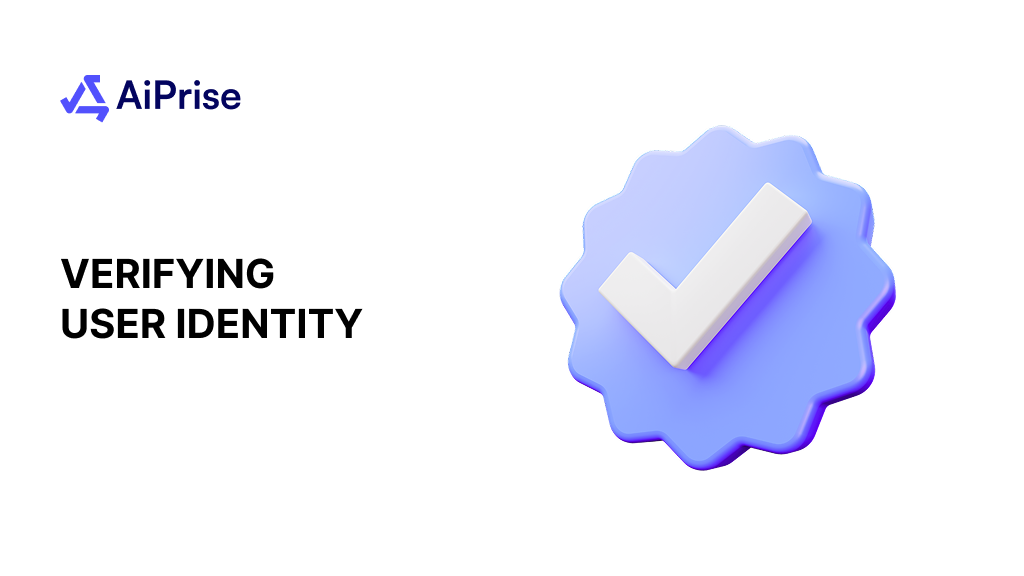
Key Takeaways










With digital interactions deeply embedded in our daily lives, knowing who you're dealing with is crucial. The alarming statistic of consumers losing over $12.5 billion to fraud last year underscores a critical truth: traditional, manual identity verification methods are no longer sufficient.
In response, AI-driven solutions, with advancements in biometric recognition and machine learning, are transforming how businesses establish trust online, making verification faster, more accurate, and inherently more secure.
This comprehensive guide will delve into the core concept of user identity verification, its critical importance for businesses, the diverse methods employed, common challenges faced, key best practices, and how modern platforms like AiPrise empower effective solutions to safeguard your digital operations.
TL;DR
- Digital identity fraud is a growing threat, costing businesses billions annually.
- Static and manual verification methods can't keep pace with evolving fraud tactics.
- AI and Machine Learning revolutionize identity verification, offering dynamic fraud detection, enhanced accuracy, and real-time risk assessment.
- Combine robust methods like document, biometric, and multi-factor authentication with AI for comprehensive security.
- Implementing advanced identity verification safeguards your business from fraud, ensures compliance, and builds customer trust.
What is User Identity Verification?
User identity verification is the process of confirming the legitimacy of an individual's identity in the digital realm. It involves validating personal details and digital behavior to ensure security and trust in online interactions.
To achieve this, businesses rely on a combination of various identity attributes and data points:
- Name: The user's full legal name, serving as a primary identifier.
- Address: A residential or business address, often validated through official documents or databases to confirm location.
- Email Address: A unique digital identifier crucial for communication, account management, and recovery.
- Phone Number: Frequently used for communication and as a key element in multi-factor authentication.
- Government-Issued ID Numbers (e.g., Social Security Number, National ID): Official identifiers often used to verify identity, especially for regulated transactions.
- Credentials: Digital access elements like usernames, passwords, or access tokens used to authenticate a user's identity within specific systems.
- Digital Footprints: These encompass a user’s online activities, such as Browse habits, transaction history, or social media interactions, which contribute to a broader digital profile.
Why is Effective Verification Critical for Business?
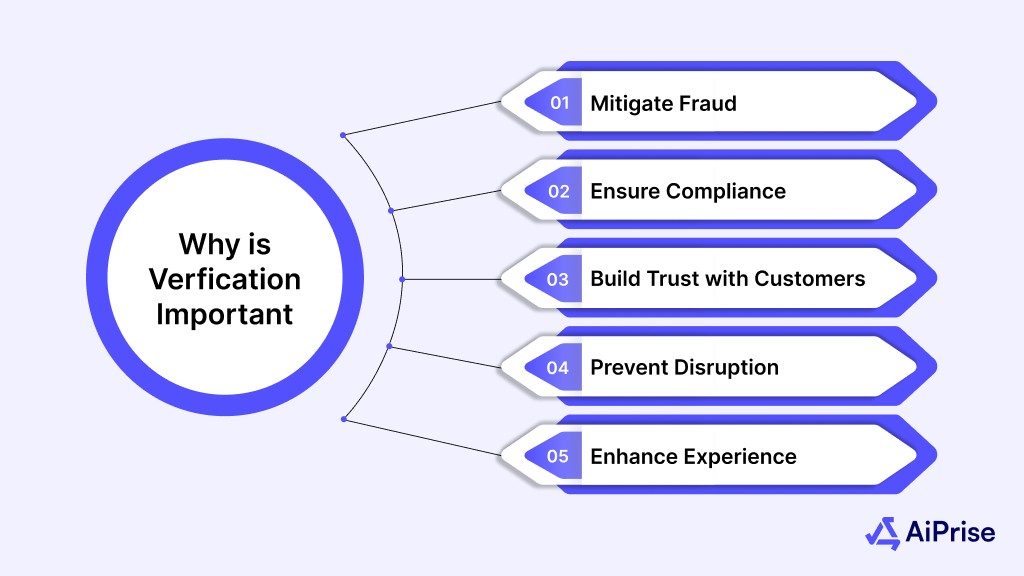
In today’s competitive environment, effective user verification is essential to prevent costly fraud and ensure operational integrity. It directly impacts the security, compliance, and customer experience that businesses offer.
- Mitigate Fraud: Verifying user identity prevents fraudulent activities such as account takeovers, synthetic identity fraud, and identity theft, safeguarding assets and revenue.
- Ensure Regulatory Compliance: Industries such as banking, finance, and healthcare face strict identity-related regulations like Know Your Customer (KYC), Anti-Money Laundering (AML), and data privacy laws such as GDPR and CCPA. Failure to comply can lead to heavy fines and severe reputational damage.
- Build Trust with Customers: Customers expect businesses to safeguard their data and provide secure interactions. A seamless yet robust verification process signals to customers that their privacy and security are taken seriously, fostering confidence and loyalty.
- Prevent Operational Disruption: Fraudulent transactions, regulatory non-compliance, or security breaches can result in significant operational bottlenecks, costly investigations, and legal challenges. Effective verification minimizes such risks, ensuring smoother business operations and continuity.
- Enhance the Customer Experience: A reliable and efficient verification system ensures legitimate customers face minimal friction during onboarding and subsequent interactions, leading to a positive user experience and higher conversion rates.
From traditional approaches to advanced technological solutions, there are several methods businesses can adopt to verify user identity effectively.
Also read: Identity Verification Solutions for Stablecoin Companies
Methods of Verifying User Identity
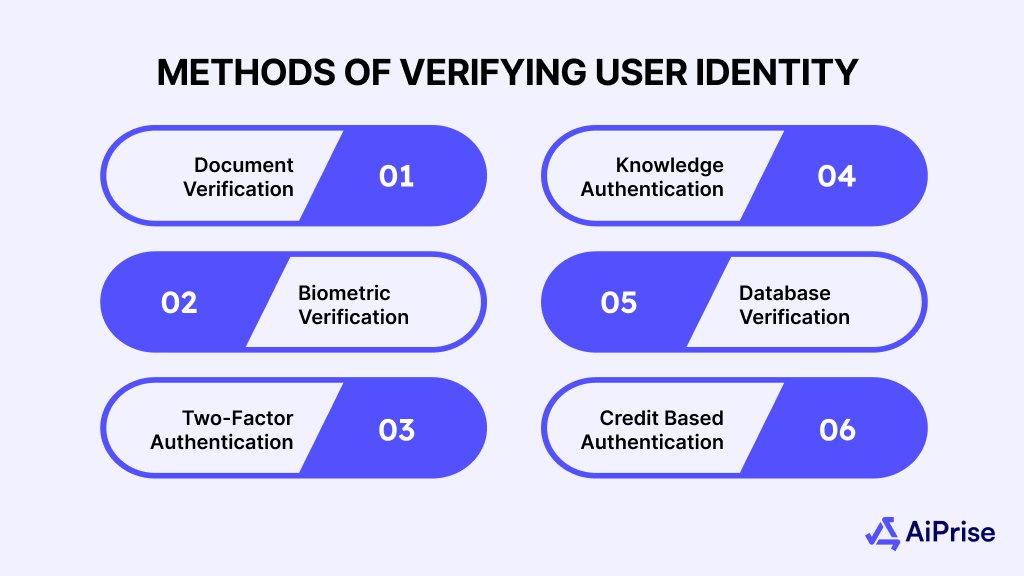
Businesses employ a range of sophisticated methods and technologies to ensure precise and secure identity checks. These approaches often work in concert, forming multi-layered verification systems that effectively detect fraud, streamline user onboarding, and enhance compliance in real-time. Each method plays a distinct role in building a robust identity verification framework.
Let's explore these core techniques in more detail.
Document Verification
Document verification is a foundational method that validates official identification documents, such as passports, driver's licenses, or national ID cards, to confirm a user's identity. It establishes a strong link to a government-verified identity.
- How it works: This process typically involves scanning or capturing an image of the document. Optical Character Recognition (OCR) technology extracts text and data from the document. This data is then analyzed by Automated Document Analysis systems, often powered by AI, to verify the document's authenticity by checking for security features (e.g., holograms, watermarks, microprinting) and detecting any signs of forgery or alteration. The extracted information is frequently cross-referenced against official databases.
- Primary Role: Provides a high level of assurance regarding identity authenticity. It's essential in sectors like financial services, e-commerce, and government for secure onboarding and fraud prevention.
Biometric Verification
Biometric verification uses unique physical or behavioral characteristics of an individual—such as fingerprints, facial recognition, or iris scans—to confirm their identity.
- How it works: This method captures an individual's biometric data through specialized devices (e.g., smartphone cameras, fingerprint scanners). This data is then analyzed and matched against a stored reference (like an enrolled template or an ID document photo).
A critical component of this process is Online and Liveness Verification, which ensures the person providing the biometric data is physically present and real, preventing spoofing attempts using photos, videos, or deepfakes through actions like blinking or head movements. - Primary Role: Offers a highly secure and convenient method of verification due to the inherent uniqueness and difficulty in replicating biometric traits. It's widely adopted in mobile device security, airport identity checks, and financial services for seamless and secure authentication.
Two-Factor Authentication (2FA)
Two-Factor Authentication (2FA), often expanded to Multi-Factor Authentication (MFA), requires users to provide two or more distinct types of evidence to verify their identity before granting access. This typically combines something the user knows (like a password), something the user has (e.g., a code from an SMS, email, or authenticator app, or a hardware token), or something the user is (a biometric scan).
- How it works: After entering a primary credential (like a password), the system prompts for a second factor, such as a one-time passcode sent to their registered phone or an approval through a dedicated authentication app.
- Primary Role: Adds a crucial, robust layer of protection against unauthorized access and account takeovers, even if one factor (like a password) is compromised. It's widely used across banking, e-commerce, and corporate systems to safeguard user accounts and sensitive transactions.
Knowledge-Based Authentication
Knowledge-Based Authentication (KBA) verifies a user's identity by requiring them to answer specific questions, often related to their personal history, financial past, or public records. The premise is that only the legitimate individual would know the answers to these unique questions.
- How it works: KBA questions can be static (pre-set questions chosen by the user) or dynamic (generated in real-time from databases based on the user's history). The user provides answers, which are then compared to stored or real-time generated data for a match.
- Primary Role: Often used for account recovery, customer service interactions, or as a secondary verification step in situations where users might have forgotten their primary credentials. Its effectiveness can be limited if the underlying personal data becomes publicly accessible through data breaches.
Database Verification
Database verification involves instantly cross-referencing user-provided personal data (such as names, addresses, or phone numbers) against trusted external databases, public records, or internal customer records to confirm their validity.
- How it works: Systems perform real-time lookups using the provided Personally Identifiable Information (PII). A match across multiple reputable databases increases the confidence in the user's claimed identity.
- Primary Role: Offers rapid, often frictionless, verification for initial checks or lower-risk scenarios. It's commonly applied in sectors like banking, insurance, and e-commerce to quickly validate customer details and verify initial information.
Credit Bureau-Based Authentication
Credit Bureau-Based Authentication specifically utilizes data from major credit bureaus (e.g., Experian, Equifax, TransUnion) to verify an individual's identity. It confirms that the personal and financial information provided by the user matches records held by these agencies.
- How it works: When a user submits their details, the system queries credit bureaus for a match. This process often includes validating elements like name, address history, and sometimes even specific financial questions related to their credit file (a form of dynamic KBA).
- Primary Role: Highly reliable for identity validation and risk assessment, particularly in lending, financial institutions, and any credit-related applications where financial history is a key factor. It also aids in identifying inconsistencies that could signal fraudulent activities.
However, the effectiveness of these methods is exponentially amplified by the transformative capabilities of Artificial Intelligence and Machine Learning.
The Transformative Power of AI and ML in User Identity Verification
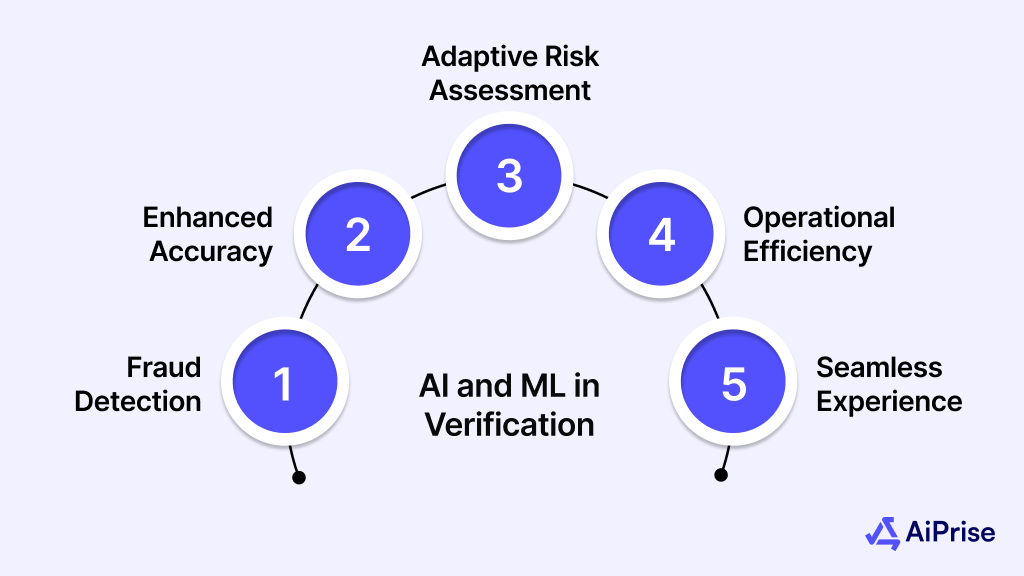
Artificial Intelligence (AI) and Machine Learning (ML) are not standalone verification methods but rather powerful underlying technologies that enhance the effectiveness and efficiency of virtually all modern identity verification processes. They utilize advanced algorithms to analyze vast amounts of user data, patterns, and behaviors.
Here's how AI and ML elevate identity verification:
- Dynamic Fraud Detection: Unlike traditional methods, AI and ML continuously learn from new data, enabling them to identify novel fraud patterns, detect synthetic identities, and recognize subtle anomalies that human analysts or older systems might miss.
- Enhanced Accuracy and Speed: By automating complex data analysis and decision-making processes, AI significantly improves the precision of identity matching, document authentication, and biometric verification, all while dramatically accelerating processing times.
- Adaptive Risk Assessment: AI-driven systems can dynamically assess risk levels based on multiple data points and behavioral cues, allowing businesses to apply appropriate verification measures in real-time and adapt to evolving threat landscapes.
- Operational Efficiency: Automation powered by AI reduces manual review burdens, lowers operational costs, and frees up human resources to focus on complex cases.
- Seamless User Experience: AI can optimize verification flows, minimizing friction for legitimate users by making intelligent, risk-based decisions on when and how to apply verification steps.
AI and ML are thus essential for advanced fraud prevention, precise risk management, and delivering scalable, secure, and user-friendly identity verification solutions in today's digital economy.
Challenges in User Identity Verification
User identity verification faces several challenges, including adapting to sophisticated fraud tactics, safeguarding privacy, and ensuring scalability. Addressing these issues requires continuous improvement and advanced technological solutions. Challenges include:
- Evolving Fraud Tactics: Methods like deepfakes, synthetic identities, and social engineering require constant updates to fraud detection systems.
- Data Privacy Concerns: Ensuring compliance with regulations like GDPR and CCPA while collecting, processing, and storing sensitive data is crucial to avoid penalties.
- Balancing Security and User Experience: Striking the right balance between stringent security protocols and maintaining a smooth, frictionless user experience is critical.
- Scalability: As businesses expand, their identity verification systems must handle growing volumes of data and users while maintaining performance and reliability.
- False Positives: Overly cautious systems can incorrectly flag legitimate users, resulting in unnecessary account lockouts and lost customer trust.
- Cost of Implementation: Integrating advanced verification technologies, such as biometrics or AI, can be expensive, making it challenging for smaller businesses.
- Regulatory Compliance: Ensuring consistent compliance with KYC, AML, and other legal requirements across global markets can be complex and resource-intensive.
Adopting the right strategies can help organizations effectively mitigate risks and enhance the efficiency of their verification systems.
Best Practices for Verifying User Identity
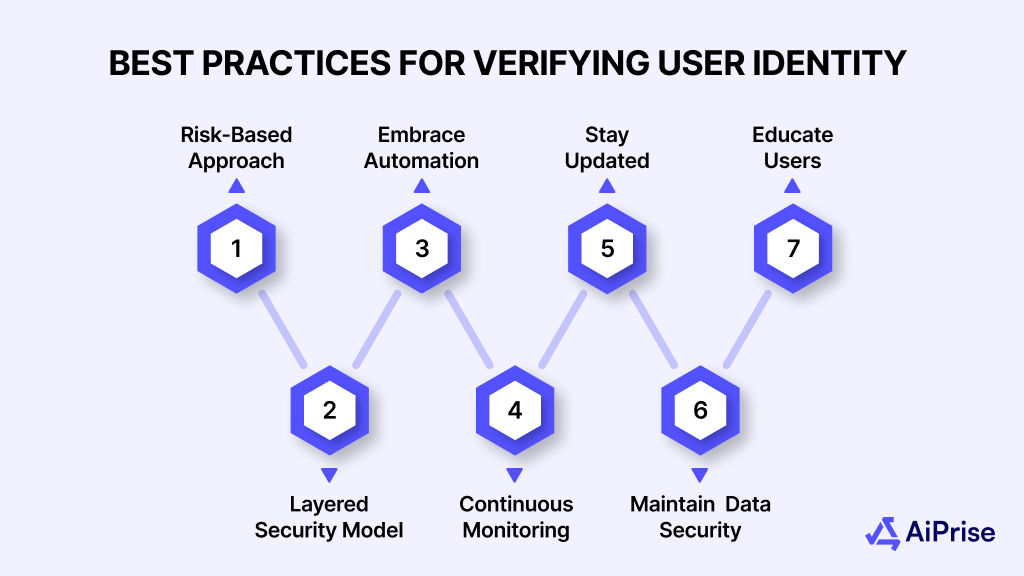
To tackle challenges like evolving fraud tactics, data privacy issues, and scalability, businesses must implement strategies that balance security with user experience. Adopting the right best practices strengthens identity verification and minimizes risks.
Here are some best practices for identity verification:
- Adopt a Risk-Based Approach: Prioritize verification methods based on the inherent risk levels of transactions and users. High-value transactions or high-risk users should trigger more stringent verification processes, potentially requiring multi-factor authentication or biometric checks.
- Implement a Layered Security Model: Combine multiple, diverse security layers. For instance, integrate document verification with biometric checks, multi-factor authentication (MFA), and passive device fingerprinting for comprehensive protection.
- Embrace Automation and AI: Utilize AI-driven tools to automate verification processes, analyze user behavior in real-time, and detect anomalies or suspicious patterns that human review might miss. AI significantly enhances speed and accuracy.
- Ensure Continuous Monitoring: Set up ongoing monitoring systems to detect suspicious activities or changes in user behavior post-onboarding, allowing for immediate response to potential threats like account takeovers.
- Stay Updated on Regulations: Regularly review and adapt verification processes to comply with evolving global and regional regulations (e.g., KYC, AML, GDPR, CCPA). Proactive compliance avoids penalties and builds trust.
- Maintain Robust Data Security and Privacy: Implement strong encryption and data protection measures for all sensitive user data collected during verification. Ensure transparency with users about data handling practices to build trust and meet privacy mandates.
- Educate Users: Regularly inform and educate users about secure online practices, the importance of identity verification, and how to identify common threats like phishing attempts. An informed user base is an additional line of defense.
Having explored the critical aspects of effective user identity verification, let's now see how a leading solution like AiPrise empowers businesses to implement these strategies seamlessly and securely.
How AiPrise Helps With User Identity Verification?
AiPrise offers AI-driven solutions for fast, secure, and reliable identity verification, including real-time KYC, KYB, and AML checks. Its advanced tools help businesses mitigate fraud, verify identities, and stay compliant with global regulations.
- Global Document Verification: Verifies over 12,000 ID document types from any country worldwide in under 30 seconds, including Document Insights to assess authenticity and validity.
- Liveness Verification: Protects against sophisticated spoofing attempts like deepfakes with instant proof of life checks, ensuring the person is physically present.
- 1:N Face Match: Utilizes advanced AI to identify and block duplicate users, preventing fraudulent onboarding and synthetic identity creation.
- Watchlist Screening: Automates screening against global sanctions, Politically Exposed Persons (PEPs), and adverse media lists to identify high-risk entities in real-time.
- Fraud & Risk Scoring: Provides comprehensive fraud detection and risk assessment, utilizing AI-powered solutions to protect against evolving digital threats.
- Step-Up KYC: Implements a dynamic, risk-based approach, allowing businesses to adjust verification intensity with basic checks or enhanced due diligence as needed.
- Case Management: Streamlines the management, escalation, and tracking of verification cases, significantly minimizing manual review time and enhancing operational efficiency.
Conclusion
Effective user identity verification is not just a regulatory hurdle or a cost center; it is a fundamental pillar for building trust, ensuring security, and driving growth in the digital economy. As fraud tactics become increasingly sophisticated, businesses must adopt an adaptive, comprehensive, and technology-driven approach, utilizing the power of AI, biometrics, and multi-layered strategies. By prioritizing robust verification, you not only protect your business from financial and reputational risks but also foster stronger customer relationships.
Ready to fortify your digital defenses? Protect your business from fraud and regulatory risks with our AI-powered identity verification solutions. Streamline your KYC/AML processes and ensure compliance with ease. Book A Demo today to see how our technology can safeguard your business from evolving risks.
FAQs
1. What is the best way to verify user identity effectively?
A: The best way is to combine multiple methods, such as biometric verification, Two-Factor Authentication (2FA), and document verification.
2. How does AI improve user identity verification?
A: AI improves identity verification by analyzing patterns and detecting anomalies in real-time, ensuring faster and more accurate checks. It adapts continuously to new fraud patterns.
3. What role does biometric verification play in user identity verification?
A: Biometric verification uses unique physical traits like fingerprints and facial recognition to confirm identity, offering a secure, hard-to-fake method of user authentication.
4. How does KYC contribute to effective user identity verification?
A: KYC (Know Your Customer) involves verifying user identity using government-issued documents and personal data, ensuring that businesses know who they are dealing with and comply with regulations.
5. Why is real-time verification important for user identity checks?
A: Real-time verification helps prevent fraud by instantly confirming a user’s identity during login or transactions, reducing the risk of unauthorized access or malicious activities.
You might want to read these...

Aiprise has helped streamline our KYB (Know Your Business) flow in 100+ countries. No other tool comes close.





Speed Up Your Compliance by 10x
Automate your compliance processes with AiPrise and focus on growing your business.





